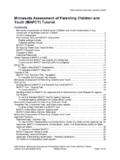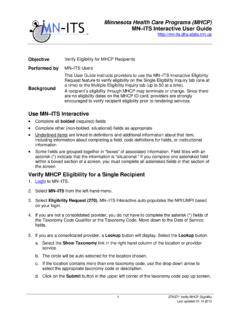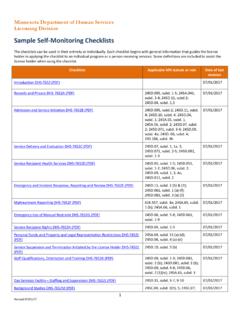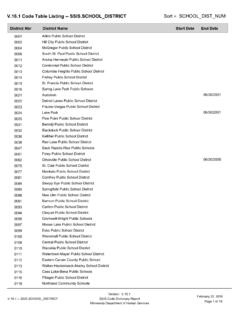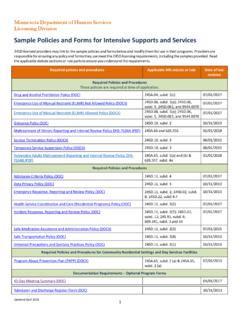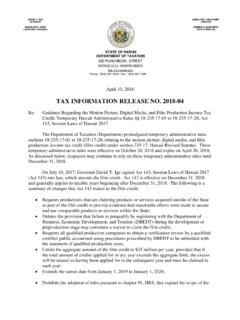Transcription of Guide to Safeguarding Federal Tax and Social Security ...
1 February 2016 Guide to Safeguarding Federal Tax and Social Security information Accessed Through MAXIS Guide to Protecting FTI Page 1 BACKGROUND As a condition of receiving Federal tax information (FTI) and certain information from the Social Security Administration (SSA) (including verification of Social Security Numbers), Minnesota county human service agencies (county agencies) as recipient agencies are required to establish and maintain, to the satisfaction of these governing Federal authorities, certain safeguards designed to prevent unauthorized use and disclosure, and to protect the confidentiality, of that information . This Guide reflects the most current Safeguarding requirements for county agencies receiving FTI and SSA information through the the Minnesota Department of Human Services (DHS) MAXIS eligibility system.
2 The topics covered in this Guide include: FTI AND SSA DEFINITIONS WHAT NEEDS TO BE PROTECTED REQUIRED ACTIONS FOR RECORD KEEPING REQUIRED ACTIONS FOR MAINTAINING SECURE STORAGE REQUIRED ACTIONS FOR DISPOSING OF FTI REQUIRED ACTIONS FOR INCIDENT REPORTING REQUIRED ACTIONS FOR EMPLOYEE AWARENESS AND PENALTIES COUNTY INSPECTION PROGRAM FTI AND SSA DEFINITIONS As a condition of receiving Federal tax information (FTI), 26 6103 requires recipient agencies to establish and maintain, to the satisfaction of the IRS, certain safeguards designed to prevent unauthorized use and disclosure of FTI and to protect the confidentiality of that information . FTI is defined as a return, return information , Federal tax offset program information , and any tax information not received directly from the party the information is about.
3 Return: any tax or information return, declaration of estimated tax, or claim for refund which includes supporting schedules, attachments, or lists which are supplemental to or part of the return. Return information : a taxpayer s identity, the nature, source, or amount of his/her income, payments, receipts, deductions, exemptions, credits, assets, liabilities, net worth, tax liability, tax withheld, deficiencies, or tax payments. It is any information that the IRS collects and uses in order to determine a person s tax liability. A taxpayer s identity means the name of a person with respect to whom a return is filed, his/her mailing address, Social Security Number, employer identification number, or account information . This can also include information about whether a person did or did not file a return. Guide to Protecting FTI Page 2 Federal tax provisions require that tax returns and return information be kept confidential.
4 It is unlawful for DHS and county employees, except as authorized by Federal law, to willfully disclose to another person return or return information . Penalt y provisio ns may also apply after an employee leaves government service. Like the IRS, Sections 1106 and 1137 of the Social Security Act also imposes penalties, requirements and limitations on use of Social Security Administration (SSA) information provided to states for IEVS program administration purposes. DHS and county human service agencies who vio late Section 1106 of the Social Security Act or Section 6103 of the IRS code risk losing access to FTI and SSA information and substantial funding for program administration. WHAT NEEDS TO BE PROTECTED FTI and SSA information are strictly defined by original source of the information . For couny agencies the source of the FTI and SSA informat ion is through the MAXIS IEVS interface when workers clear matches or the SSA SVES / TPQY function.
5 FTI is Federal tax return and return information that comes directly from the IRS such as the IEVS Unverified Unearned Income (UNVI) record. FTI can also be tax information from other agencies such as the IEVS Beneficiary Earnings and Exchange Record (BEER) that is received via the IEVS interface from SSA. However, if an individual provides their own tax information or the third party payer identified in the UNVI or BEER match provides information to the agency after the client authorizes the release of information , then the linkage to IRS or SSA is broken and the information is not considered Federal tax or Social Security information . An SSN provided to the agency is not considered SSA information . SSN verification indicators displayed as having been verified through SSA TPQY response would be considered SSA information .
6 FTI and SSA information requiring Safeguarding includes the following MAXIS panels and functions : o IEVS UNVI and BEER panels or screen prints thereof is FTI. o IEVS BNDX and SDX panels informat ion or screen prints thereof is SSA information . o ILA and IULB panels if for UNVI or BEER match is FTI. o IDLA and IDLB panels if for UNVI or BEER match is FTI. o MAXIS SVES TPQY responses or screen prints thereof is SSA o MAXIS IEVS UNVI and BEER Difference Notice Mailings triggered by agency workers and mailed out through the IOC is considered FTI o MAXIS BNDX and SDX panels with SSA responses is SSA informat ion. o Undeliverable mail containing IEVS Difference Notices returned to agency mail rooms and forwarded to county agency workers is FTI returned to agency. Since the source of the match information is not specified on the notice, all IEVS Difference Notices returned to the agency as undeliverable must be treated as FTI.
7 O Verification indicators/messages within MAXIS linking SSA as verification source for TPQY responses, citizenship, or prisoner facilities matches. In order to carry out the requirements of 26 6103, the IRS publishes and provides Guide to Protecting FTI Page 3 electronic access to Publication 1075 - Tax information Security Guidelines for Federal , State, and Local Agencies and Entities through the IRS Safeguard website at IRS Safegaurds Progam. Publication 1075 gives guidance on ensuring that the policies, practices, controls, and safeguards employed by agencies adequately protect the confidentiality of the information received fro m the IRS. The directives outlined in Publication 1075 are mandatory. DHS is required by Federal law and its computer matching agreements with the IRS and SSA to protect FTI and SSA information and to ensure that its affiliated county agencies are also in compliance with all Federal Safeguarding regulations.
8 REQUIRED ACTIONS FOR RECORD KEEPING Returned Mail IEVS Difference Notice Mailings County agencies must identify, track and dispose of returned IEVS Difference Notice mailings. The tracking of these mailings starts when the returned notice mailing enters the county mail room. DHS added a message indicator to the first line of the return address tit led IEVS Sensitive information . The intent of this message indicator is to alert county workers that these notices are required to be treated as FTI and that IRS Safeguarding and tracking requirements apply. The message indicator is clearly visible through the unopened return address envelope window or on the first line of the return address if taken out of the envelope. See Attachment A, IEVS Difference Notice with IEVS sensitive information message indicator.
9 Even though the match source information is indistinguishable, all undeliverable returned IEVS Difference Notices from the post office must be treated as potentially FTI. However, when clients inadvertently return the IEVS Difference Notice (page 1 of the mailing) along with their signed release (page 2), the page 1 IEVS Difference Notice is no longer considered FTI because the client broke the direct link between the agency and the IRS source of the FTI. In these instances, separate the notice from the release and destroy the notice per agency private data destruction procedures. Maintain Destruction Logs Wit h the main source of FTI residing in the secure MAXIS IEVS interface panels, the only non-electronic (paper) source of FTI entering agencies from the outside will be the IEVS Difference Notice mailings.
10 With the use of the IEVS Sensitive information indicator, counties must now begin treating the notices as containing FTI and track them in an FTI Destruction Log. If the IEVS Difference Notice is re-mailed upon learning of the correct address from the post office, the notice must still be logged, secured and re-mailing date listed on the log. In future audits, counties must be able to produce this log as evidence of their following Safeguarding procedures for tracking and destroying paper generated FTI. See Attachment B for a template of an FTI Destruction Log that counties can use. At a minimum, the log must contain the following elements: date FTI was received case # type of information (IEVS Difference Notice) where the data is stored before destruction stored, cabinet. authorized individuals Logon ID Guide to Protecting FTI Page 4 date FTI was destroyed or re-mailed to client method of destruction who destroyed authorized agency witness Update Visitor Registration Procedures and Logs Per IRS Publication 1075, A restricted area visitor log must be maintained at a designated entrance to the restricted area and all visitors (persons not assigned to the area) entering the area shall be directed to the designated entrance.
